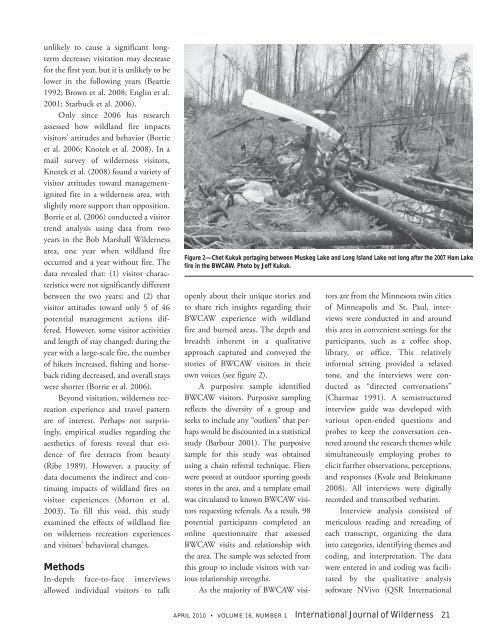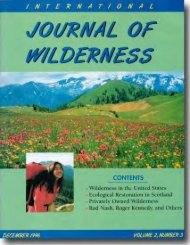Ten Tribes Reclaiming, Stewarding, and Restoring Ancestral Lands
Ten Tribes Reclaiming, Stewarding, and Restoring Ancestral Lands
Ten Tribes Reclaiming, Stewarding, and Restoring Ancestral Lands
Create successful ePaper yourself
Turn your PDF publications into a flip-book with our unique Google optimized e-Paper software.
unlikely to cause a significant longterm<br />
decrease; visitation may decrease<br />
for the first year, but it is unlikely to be<br />
lower in the following years (Beattie<br />
1992; Brown et al. 2008; Englin et al.<br />
2001; Starbuck et al. 2006).<br />
Only since 2006 has research<br />
assessed how wildl<strong>and</strong> fire impacts<br />
visitors’ attitudes <strong>and</strong> behavior (Borrie<br />
et al. 2006; Knotek et al. 2008). In a<br />
mail survey of wilderness visitors,<br />
Knotek et al. (2008) found a variety of<br />
visitor attitudes toward managementignited<br />
fire in a wilderness area, with<br />
slightly more support than opposition.<br />
Borrie et al. (2006) conducted a visitor<br />
trend analysis using data from two<br />
years in the Bob Marshall Wilderness<br />
area, one year when wildl<strong>and</strong> fire<br />
occurred <strong>and</strong> a year without fire. The<br />
data revealed that: (1) visitor characteristics<br />
were not significantly different<br />
between the two years; <strong>and</strong> (2) that<br />
visitor attitudes toward only 5 of 46<br />
potential management actions differed.<br />
However, some visitor activities<br />
<strong>and</strong> length of stay changed: during the<br />
year with a large-scale fire, the number<br />
of hikers increased, fishing <strong>and</strong> horseback<br />
riding decreased, <strong>and</strong> overall stays<br />
were shorter (Borrie et al. 2006).<br />
Beyond visitation, wilderness recreation<br />
experience <strong>and</strong> travel pattern<br />
are of interest. Perhaps not surprisingly,<br />
empirical studies regarding the<br />
aesthetics of forests reveal that evidence<br />
of fire detracts from beauty<br />
(Ribe 1989). However, a paucity of<br />
data documents the indirect <strong>and</strong> continuing<br />
impacts of wildl<strong>and</strong> fires on<br />
visitor experiences (Morton et al.<br />
2003). To fill this void, this study<br />
examined the effects of wildl<strong>and</strong> fire<br />
on wilderness recreation experiences<br />
<strong>and</strong> visitors’ behavioral changes.<br />
Methods<br />
In-depth face-to-face interviews<br />
allowed individual visitors to talk<br />
Figure 2—Chet Kukuk portaging between Muskeg Lake <strong>and</strong> Long Isl<strong>and</strong> Lake not long after the 2007 Ham Lake<br />
fire in the BWCAW. Photo by Jeff Kukuk.<br />
openly about their unique stories <strong>and</strong><br />
to share rich insights regarding their<br />
BWCAW experience with wildl<strong>and</strong><br />
fire <strong>and</strong> burned areas. The depth <strong>and</strong><br />
breadth inherent in a qualitative<br />
approach captured <strong>and</strong> conveyed the<br />
stories of BWCAW visitors in their<br />
own voices (see figure 2).<br />
A purposive sample identified<br />
BWCAW visitors. Purposive sampling<br />
reflects the diversity of a group <strong>and</strong><br />
seeks to include any “outliers” that perhaps<br />
would be discounted in a statistical<br />
study (Barbour 2001). The purposive<br />
sample for this study was obtained<br />
using a chain referral technique. Fliers<br />
were posted at outdoor sporting goods<br />
stores in the area, <strong>and</strong> a template email<br />
was circulated to known BWCAW visitors<br />
requesting referrals. As a result, 98<br />
potential participants completed an<br />
online questionnaire that assessed<br />
BWCAW visits <strong>and</strong> relationship with<br />
the area. The sample was selected from<br />
this group to include visitors with various<br />
relationship strengths.<br />
As the majority of BWCAW visi-<br />
tors are from the Minnesota twin cities<br />
of Minneapolis <strong>and</strong> St. Paul, interviews<br />
were conducted in <strong>and</strong> around<br />
this area in convenient settings for the<br />
participants, such as a coffee shop,<br />
library, or office. This relatively<br />
informal setting provided a relaxed<br />
tone, <strong>and</strong> the interviews were conducted<br />
as “directed conversations”<br />
(Charmaz 1991). A semistructured<br />
interview guide was developed with<br />
various open-ended questions <strong>and</strong><br />
probes to keep the conversation centered<br />
around the research themes while<br />
simultaneously employing probes to<br />
elicit further observations, perceptions,<br />
<strong>and</strong> responses (Kvale <strong>and</strong> Brinkmann<br />
2008). All interviews were digitally<br />
recorded <strong>and</strong> transcribed verbatim.<br />
Interview analysis consisted of<br />
meticulous reading <strong>and</strong> rereading of<br />
each transcript, organizing the data<br />
into categories, identifying themes <strong>and</strong><br />
coding, <strong>and</strong> interpretation. The data<br />
were entered in <strong>and</strong> coding was facilitated<br />
by the qualitative analysis<br />
software NVivo (QSR International<br />
APRIL 2010 VOLUME 16, NUMBER 1 International Journal of Wilderness 21










